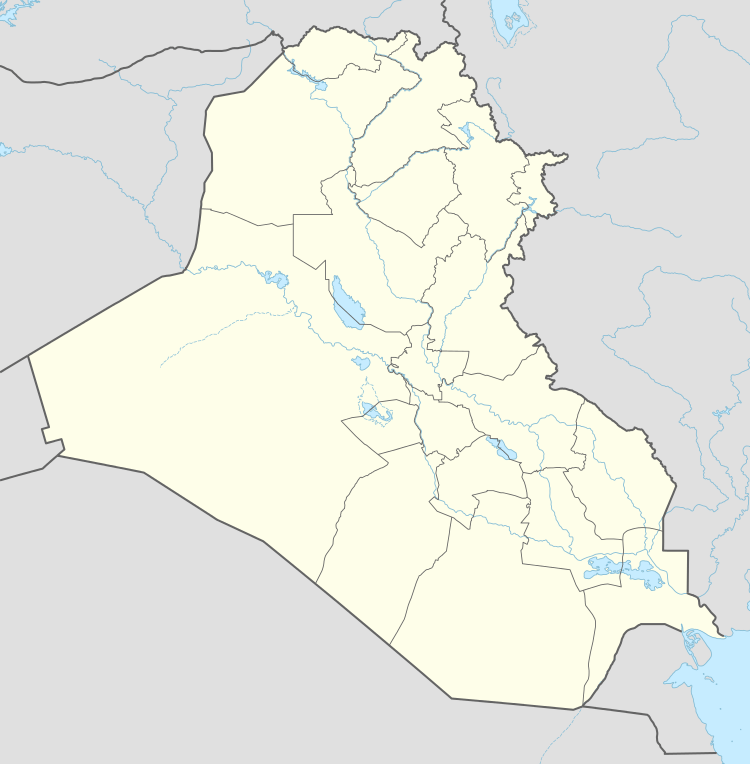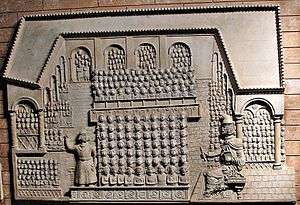Sura Academy
Sura Academy (Hebrew: ישיבת סורא) was a Jewish yeshiva located in Sura, Babylonia. With Pumbedita Academy, it was one of the two major Jewish academies from the year 225 CE at the beginning of the era of the Amora sages until 1033 CE at the end of the era of the Gaonim. Sura Yeshiva Academy was founded by the Amora Abba Arika ("Rav"), a disciple of Judah ha-Nasi. Among the well-known sages that headed the yeshiva were Rav Huna, Rav Chisda, Rav Ashi, Yehudai Gaon, Natronai Gaon, Saadia Gaon, and others.
Sura סורא | |
|---|---|
 Sura | |
| Coordinates: 31°52′00″N 44°27′00″E | |
| Country | |
History

Rav (Abba Arikha) arrived at Sura city to find no lively Jewish religious public life, and since he was worried about the continuity of the Jewish community in Babylonia, he left his colleague Samuel of Nehardea in Nehardea and began working to establish the yeshiva that would become Sura Academy. Upon Rav's arrival, teachers from surrounding cities and towns descended upon Sura. The Academy of Sura was formally founded in the year 225 CE, several years after Rav's arrival.
Sura Academy would eventually grow to include a faculty of 1200 members and included the following features:
- Eksedrah (אכסדרא), a covered walkway leading from the street up to the house of learning
- Kiton (קיטון), offices for the rabbis and deans and classrooms for teachers
- Ginatah (גינתא), garden whose produce fed the academy's teachers and students
- Tsipi (ציפי), flat mats placed on the floor, where teachers and students could rest between classes
Sura Academy soon became the most influential yeshiva in its region, besting the Nehardea Academy.
The academy's classes were occasionally held at Matha-Mehasia (מתא מחסיא), a suburb of Sura city, and after a while a Torah center was founded there as well.
List of Sura academy's Deans
| Rabbinical eras |
|---|
Amora era
- Abba Arikha ("Rav") (founder of the academy)
- Rav Huna (Rosh yeshiva, after Rav, for about 40 years)
- Rav Chisda
- Rav Ashi
- Maremar
- Idi ben Abin (II)
- Nachman ben R. Huna
- Mar ben R. Ashi (Tabyomi)
- Rabbah Tosafa'ah
- Ravina II
Savora era
Gaonim era [1][2][3]
- Mar ben R. Huna - 591
- R. Hanina (Hananiah, Hinenai) - around 610
- Rav Hunai (Huna) - around 650
- Rav Sheshna (Sheshua, Mesharsheya b. Tahlifa) - around 670
- Hanina of Nehar Pekkod (Hananiah, Hinenai, Ha-Kohen, of Nhr[River] Paqod) - 689-694
- Hillai of Naresh (Nehilai, Ha-Levi) - 694-712
- Jacob of Nehar Pekod (Ha-Kohen, Nhr Paqod) - 712-730
- Rav Samuel Gaon (of Pumbedita) (Rabba's grandson, descendant of Amemar) - 730-748
- Mari ha-Kohen of Nehar Pekod (Nahr Paqod)- 748-756
- Rav Aha Gaon - 756
- Yehudai ben Nahman (Yehudai Gaon, Judah) (Author of Halakhot Pessoukot) - 757-761
- Ahhunai Kahana ben Papa (Ahunai, Huna, ha-Kohen) - 761-769
- Haninai Kahana ben R. Huna (Hanina, ha-Kohen, Ahunai) - 769-774
- Mari ha-Levi ben R. Mesharsheya - 774-778
- Bebai ha-Levi ben R. Abba of Nehar Pekod (Biboi, Nahr Paqod) - 778-789
- Hilai ben R. Mari (Hillai) - 789-798
- Jacob ha-Kohen ben Mordecai (Mordechai) - 798
- Rav Abimai (Abumai, Ikhomai, ha-Kohen) (brother of R. Mordecai) - 815
- Zadok ben R. Ashi (Issac Sadoq, ben Jesse) - 810-812
- Hilai ben R. Hananiah (Hillai) - 812-816
- Kimoi ben R. Ashi (Qimoi) - 816-820
- Mesharsheya Kahana ben Jacob Gaon (Moses, ha-Kohen) -820-830
- Two years of an absence of a Gaon(843-844)
- Kohen Tzedek ben Abimai Gaon (Sedeq, Ikhomai, Abumai) - 832-843
- Sar Shalom ben Boaz - 843-853
- Natronai ben R. Hilai ben R. Mari Gaon (Natronai ben Hilai)- 853-861
- Amram bar Sheshna (Amram Gaon, Amram ben R. Sheshna) (Author of the Siddur) - 861-872
- Nahshon ben R. Zadok - 872-879
- Zemah ben R. Hayyim - (Semah) 879-886
- Rav Malka - 886
- Hai ben R. Nahshon ben Tzadok (ben Issac Sadoq) - 886-896
- Hilai ben Natronai ben Hilai Gaon (Hillai, Natrunai) - 896-904
- Shalom ben R. Mishael - 904
- Jacob ben R. Natronai (ha-Kohen, Natrunai) - 911-924
- Yom-Tob Kahana ben R. Jacob (Yom Tov, ha-Kohen) - 924
- Saadia ben Joseph of Faym (Al-Fayyumi, Saadia Gaon) - 928-942
- Joseph ben Jacob bar Satya (ben Satya) - around 930
- The academy was closed for about 45 years
- Zemah Tzedek ben Paltoi ben Isaac (Semah, Sedeq) - around 990 and around 998
- Samuel ben Hofni (Hophni, ha-Kohen) (father-in-law of Hai Gaon) - around 998 and around 1012
- Dosa ben Saadia Gaon (Son of Saadia Gaon) - 1012-1018
- Israel ha-Kohen ben Samuel ben Hofni (Hophni) - 1018-1033
See also
- History of the Jews in Iraq
- Talmudic Academies in Babylonia
- Firuz Shapur, modern-day Anbar, a town adjacent or identical to Nehardea; academy of Pumbedita was moved to this town for half of the 6th century
- Mahuza, modern-day Al-Mada'in; the academy of Pumbedita was relocated to Mahuza during the time of the Amora sage Rava
- Nehardea Academy (in Nehardea)
- Pumbedita Academy (in Pumbedita for most of its history, near modern-day Fallujah)
- Pum-Nahara Academy
- Sura (city) - the political centre of Jewish Babylonia after Nehardea
- Talmudic Academies in Syria Palaestina (in the Land of Israel)
References
- The list names in accordance with Hebrew Wikipedia; & Jewish Encyclopedia - Gaon- Synchronistic List of the Geonim of Sura and Pumbedita
- The list names is also based on "Jews in Islamic countries in the Middle Ages", Moshe Gil, p. 404 - A Chronological List of the Geonim of Sura and Pumbedita
- The list dates are in accordance with the work of Prof. Moshe Gil, "Kingdom of Israel in the Gaonic era", 1997 (in Hebrew). Some of the information concerning the dates are based on factual sources, however, some are based on premises, in the absence of authoritative sources or due to contradiction between sources. There is a dispute among the scholars concerning some of the dates, and not all is agreed upon.